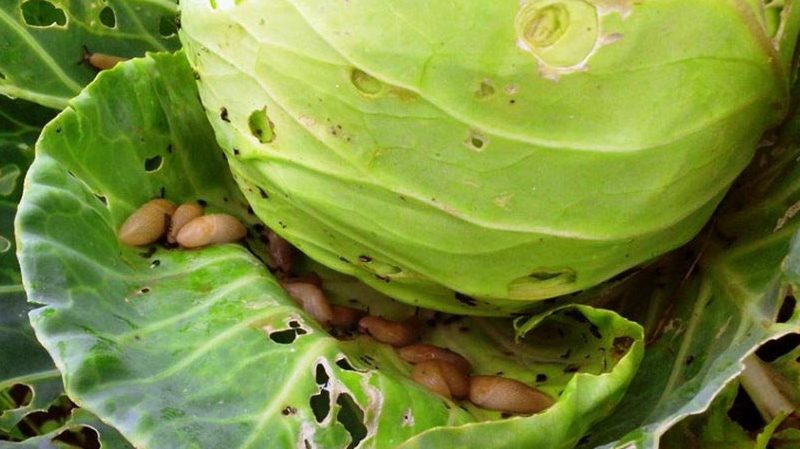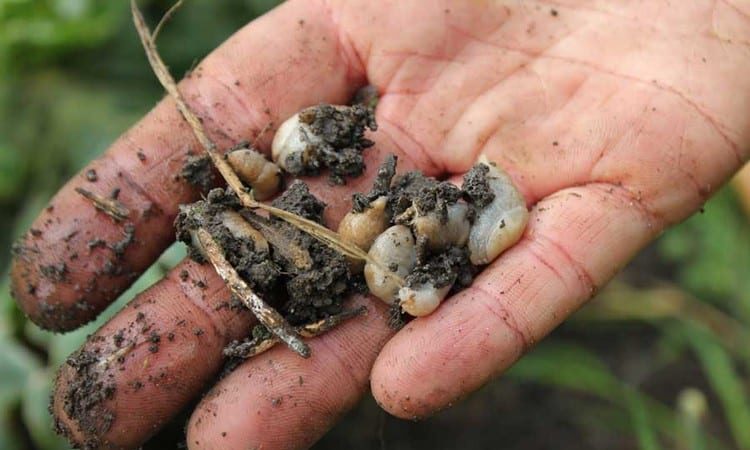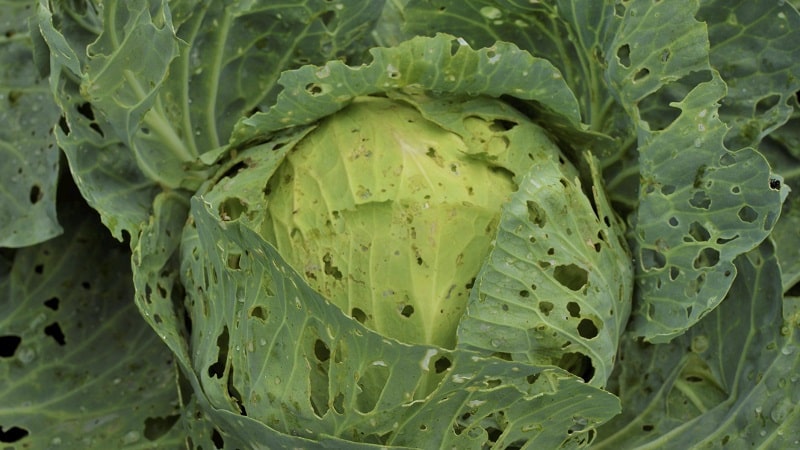Proven ways to get rid of slugs on cabbage
Slugs are very dangerous cabbage pests. They can render a large number of heads of cabbage unusable or completely destroy a vegetable crop. Dealing with them is very problematic, but possible. In this article we will tell you how to get rid of slugs on cabbage.
Signs of cabbage being damaged by slugs
Gastropods, despite the lack of a shell, are very tenacious and hardy. During the daytime, slugs are almost impossible to see on the site, because they hide from sunlight in dark and damp places: in weeds, under the top leaves of cabbage.
Late in the evening, pests crawl out of hiding and feast on tender young cabbage leaves until the morning. They are especially active in rainy weather when air humidity is high.

It is easy for experienced summer residents to detect the pest and recognize it by holes of different sizes on the leaves. The voracious mollusks leave behind a trail of mucus. It protects the body from drying out and helps the pest move. As the mucus dries, it acquires a silvery tint, which is clearly visible on cabbage leaves.
Attention! If you examine the heads of cabbage, you can find the passages that pests make in them.
Damage caused
Slugs are large pests that, in the absence of special processing capable of destroying the entire cabbage crop. However, the degree of damage depends not only on their size, but also on their number.
Mollusks are endowed with powerful jaws, so they destroy plantings with great speed. They do not eat the entire head of cabbage, but damage it so much that it becomes unsuitable for consumption or further storage. This pest attacks all types of cabbage: white cabbage, broccoli, Peking cabbage, cauliflower, Brussels sprouts.
Reference. Red cabbage suffers less from slug infestations than other varieties.
In addition to the fact that pests eat succulent shoots of the plant, they spread fungal infections and other illnesses, affecting the volume of harvest. Their saliva contains a special enzyme, which causes the leaves of the vegetable to become covered with dark spots, after which signs of rot appear.
Sometimes the damage caused by diseases is greater than that caused by mechanical damage from slugs.
Causes
There are several factors that contribute to the occurrence of pests on the site:
- Too humid climate or stagnant water in the garden.
- Excessive watering, especially when there is no drainage system.
- Vegetables have poor immunity.
- Slugs are attracted to the juicy leaves of young cabbage.
Ways to get rid of slugs on cabbage
To protect cabbage from slugs, various methods are used. Considered the safest folk remedies, but the most effective are chemicals.
Chemicals
The easiest way is to use chemicals to control slugs. The main active ingredient of such drugs is metaldehyde. Solid, insoluble granules act upon contact and ingestion.
The most common chemical repellents for slugs:
- «Meta". Has a contact-intestinal effect. This drug is produced in dry form.After the granules are scattered in the space between the rows, the slugs begin to group under the leaves of the cabbage heads and die there. Meta is also produced in powder form. They powder heads of cabbage with it for prevention. The drug is used no later than 3 weeks before harvesting cabbage from the beds.

- "Ulicide." The product is made on the basis of iron phosphate salt. It is considered not as toxic to people and animals as the previous one. When the active substance enters the pest’s body, it causes very rapid dehydration. The slug dies within 40 minutes. This product is used no more than 2 times during the entire season.
- "Ecokiller". A natural preparation, which is made on the basis of diatomite, in powder form. It also has a dehydrating effect on pests. At the same time, Ecokiller is not dangerous for people and animals. For 1 sq. m scatter 20 g of powder.
- "Slug eater." The product is produced in the form of granules. In 3-4 days it causes the death of the slug population. For 10 sq. m of beds use 30 g of the drug.
When using chemicals against pests, it is advisable to use personal protective equipment: gloves, a face mask and clothing made of thick fabric.
Traditional methods
Often gardeners prefer to use traditional methods of pest control. Ingredients for cooking are always available.
The most common means:
- Coffee solution. Both ground and instant coffee are used for spraying. The drink is made very strong. After cooling, spray the heads of cabbage and the space between them.
- Ammonia solution. To combat slugs, a solution is often used, which is prepared from 1 part ammonia and 6 parts water.Spraying helps effectively control pests, but does not harm cabbage. The main thing is to use this method no more than once a week, so as not to cause the vegetables to dry out.
Agrotechnical techniques
Many summer residents create a kind of obstacle course that prevents slugs from getting to the cabbage. Sand, crushed shells and eggshells or sawdust are scattered around the perimeter of the beds. Soft-bodied pests are not able to overcome such a barrier.

How else to deal with them:
- Early varieties are covered with film. Pests cannot tolerate heat. During the daytime, a greenhouse effect is created under the film. This leads to the death of the slugs. This method is not used for late varieties, as this often leads to rotting of the roots.
- Young cabbage is watered with warm water (about 50°C). This will not harm the plant, but the pests will definitely die.
- Regularly feed the crop with mineral fertilizers, for example, superphosphate or potassium salt. They are scattered around plants.
- Make sure there are no weeds around the garden bed.
Mechanical methods

The easiest way is to walk around the area every day and collect slugs by hand.. This method does not require additional costs or the use of chemicals, but is not the most effective.
To simplify the process, traps are made on the site. Slugs love the aroma of beer, jam, compote and syrup. Trimmed bottles are dug into the garden bed and filled with treats for pests. Slugs have a very keen sense of smell. By the next morning there will be many individuals in each trap.
Important! The trap method also has its drawbacks. Beneficial insects, such as bees, will also respond to the bait.
The most effective methods
All of the above methods have varying effectiveness. The safer the product, the worse it works. Therefore, in extreme cases, the most powerful drugs are used.
Killer mixture against cabbage slugs
The entire soil between the rows and individual heads of cabbage is pollinated with lime. This will prevent pests from hiding in cracks in the ground.
After this, the chemical preparation “Thunderstorm” is scattered. Now this is the most effective remedy for slugs. It acts precisely, killing these pests. Made with metaldehyde.
Experience using Groza has shown that the granules attract slugs. This quickly leads to the death of the entire population. The drug is relatively safe for birds, animals and beneficial insects.
Slug-resistant cabbage hybrids

Breeders are breeding hybrids that are less susceptible to attack by slugs:
- F1 sprinter. It has a dense and oval head weighing 1-1.5 kg. The color in section is milky yellow. The hybrid has good taste. Pest attacks only occur when agricultural practices are incorrect.
- Start of F1. This cabbage is designed for dense planting. Weakly susceptible to diseases and pests.
- Transfer F1. This hybrid is practically not affected by pests and diseases. The disadvantage is that the shelf life of heads of cabbage after harvesting from the garden does not exceed 1 month.
- Aggressor F1. It has good immunity, due to which it is rarely damaged by pests. This is an undemanding crop that tolerates unfavorable conditions well.
Preventive measures
Getting rid of slugs is much more difficult than preventing their appearance. Therefore, gardeners try to pay attention to prevention:
- Pests love dark and damp places. They breed under fallen leaves and rotting firewood.It is important to regularly clear the area of such debris and remove weeds.
- The top layer of soil is loosened to prevent moisture from accumulating.
- Set up sand obstacles around the beds. This is especially important if the site is located near bodies of water.
- Dig in the spring. At the end of summer, slugs lay eggs in the upper layers of the earth. The larvae appear in late spring. If you dig up the garden in early spring, all the embryos will die.
- After harvesting, all plant debris is immediately collected.
- Tobacco dust or ash is sprinkled around the holes every 2 weeks.
- Sprinkle the soil with superphosphate. This substance quickly absorbs mucus, causing slugs to lose their ability to move.
- Pests often use the lower leaves of cabbage as a home. Experts recommend removing these parts of the plant in a timely manner.
Helpful Tips and Mistakes to Avoid

To make cabbage resistant to diseases and various pests, it is regularly fed. Superphosphate or potassium salt is added to the soil. In autumn and spring, organic matter is added during digging. It allows you to saturate the soil with useful substances and improve its acidity. Organic matter serves as a means of prevention against slugs, as it increases plant immunity. During the growing season, cabbage is fed at least 3 times.
In addition to slugs, the crop is attacked by aphids, cruciferous flea beetles, cabbage beetles, and leaf beetles. To prevent the appearance of most pests, it is recommended to plant carrots between the rows of cabbage.
It is important to monitor the humidity level. With excessive watering, the occurrence of slugs is guaranteed.
Conclusion
Cabbage is not a very fastidious crop, but it is often attacked by slugs.These pests are capable of destroying most of the crop. To deal with them, chemicals are most often used. This is the simplest and most effective way.